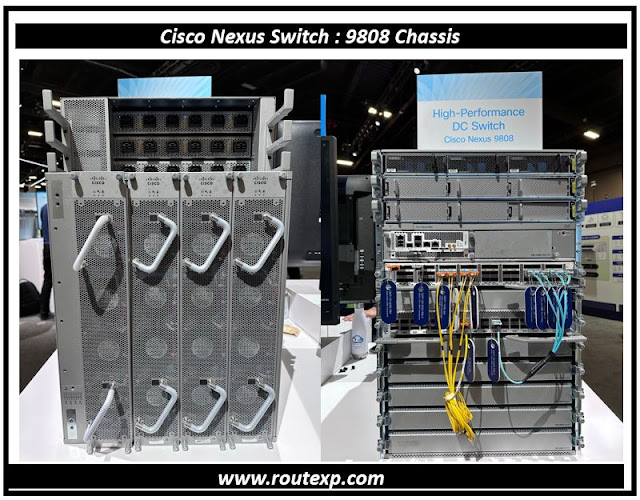Important about Cisco NX-OS
Important about Cisco NX-OS
Cisco NX-OS is a network operating system that powers the modern data center. It is designed for flexibility, scalability, modularity, and improved performance.
It supports both physical and virtual data center deployments, and offers various features and benefits such as:
 |
| Fig 1.1- Cisco Nexus 9808 Device |
- Architectural flexibility with VXLAN EVPN, segment routing, and VXLAN multisite
- Operational simplicity with Cisco Nexus Dashboard Fabric Controller, industry-standard APIs, and DevOps automation tools
- End-to-end visibility with granular flow and ASIC telemetry, control plane monitoring, and MACSEC encryption
- High-performance networks for AI/ML with non-blocking networks, ultra-low latency switches, and congestion management solutions
⭐ Lets talk about more on Cisco NX-OS
- The OSPF feature supports stateful process restarts and In-Service-Software-Upgrades (ISSU) if two supervisors are present in a chassis.
- OSPF command-line interface (CLI) configuration and verification commands are not available until you enable the OSPF feature with the feature ospf command.
- The OSPF protocol requires the Enterprise Services license.
- The OSPF instance can consists of 20 characters, whereas the IOS supports numbers 1 to 65536.
- Eight equal-cost paths are supported by default. You can configure up to sixteen.
- The default reference bandwidth used in the OSPF cost calculation is 40 Gbps.
- Networks and interfaces are added to an OSPF instance under the interface configuration mode.
- An OSPF area can be configured using decimal or decimal dotted notation, but it is always displayed in decimal dotted notation in the configuration and in the show command output.
- Passive interfaces are applied to the interface as opposed to under the OSPF router instance. Loopback interface is considered to be passive by default.
- If a router ID is not manually configured, the loopback 0 IP address is always preferred. If loopback 0 does not exist, Cisco NX-OS selects the IP address for the first loopback interface in the configuration. If no loopback interfaces exist, Cisco NX-OS selects the IP address for the first physical interface in the configuration.
- Neighbor adjacency changes are not logged by default. The log-adjacency-changes CLI command is required under the OSPF instance.
- When interface authentication is configured, the OSPF key is encrypted with Data Encryption Standard 3 (3DES) in the configuration. Cisco IOS Software requires the service password command.
- The NX-OS does not support distribute-lists used to remove OSPF routes from the routing table. The NX-OS does support inter-area Type-3 LSA/route filtering using the filter-list command configured under the OSPF routing instance.
- A route-map is always required when redistributing routes into an OSPF instance. In Cisco IOS Software, a route-map is optional.
- Route redistribution advertises classless and classful networks by default (no subnets option). Cisco IOS Software requires the subnets option to redistribute classless networks.
- A VRF instance is configured under an OSPF instance (Numerous VRF instances can be associated to a single OSPF instance). In Cisco IOS Software, a VRF instance is associated to a single OSPF process in a one-to-one relationship.
- When a NX-OS device runs two independent OSPF processes, the prefix metric is learnt as different types in both the processes. The lower metric (among the two different types) is installed into the routing table. This may result in a OSPF prefix with a non-best type getting installed into RIB. Also, if metrics for both processes are equal both of them will be installed into RIB. This can lead to unexpected load-balancing situation. The work around for this issue is to tune the metrics so that the external prefixes would always have higher metric than the internal prefix.
- Four OSPF instances can be configured per virtual device context (VDC).
- If you remove the feature ospf command, all relevant OSPF configuration information is also removed.
- The shutdown command under the OSPF process can be used to disable OSPF while retaining the configuration. Similar functionality can also be applied per interface with the ip ospf shutdown command.
- The show running-config ospf command displays the current OSPF configuration.
- An OSPF instance can be restarted with the restart ospf <instance> Exec command. Graceful Restart (RFC 3623) is enabled by default.
- You cannot configure multiple OSPF instances on the same interface.
- An interface can support multi-area adjacencies using the multi-area option with the ip router ospf interface command.
- Secondary IP addresses are advertised by default, but can be suppressed per interface with the ip router ospf <instance> area <#> secondary's none interface command.
- By default, all loopback IP address subnet masks are advertised in an LSA as a /32. The loopback interface command ip ospf advertise-subnet can be configured to advertise the primary IP address subnet mask. (This command does not apply to secondary IP addresses. They will still be advertised as a /32.)
- OSPF supports Bidirectional Forwarding Detection (BFD), which can be configured to reduce network convergence time to less than 1 second.
- When you rollover an OSPF authentication key in a combined Cisco NX-OS/Cisco IOS network, you should configure both keys on the Cisco NX-OS router to ensure that there is sufficient overlap between the old key and the new key for a smooth transition to the new key. You should configure the new key as a valid accept key on all the NX-OS and IOS routers before the new key becomes a valid generation key in the keychain. During the overlap period, Cisco NX-OS transmits the new OSPF key and accepts OSPF authenticated packets from both the old key and the new key.
- Maximum prefix thresholds (warning and withdraw) can be configured for redistributed routes using the redistribute maximum-prefix routing instance command.











